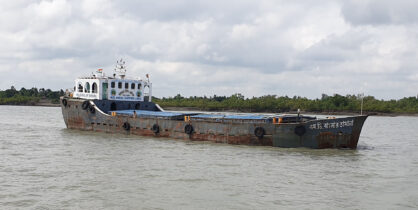Introducing the Sundarbans
Sundarbans – the largest mangrove forest on earth – reveals the real challenges of ecosystem restoration.
Despite its resilience, the Sundarbans ecosystem is under siege from multiple fronts. Climate change poses a significant threat, with rising sea levels and more frequent, intense storms leading to erosion and flooding. These changes jeopardize the delicate balance of this habitat, endangering the species that call it home. The cumulative impact of these threats is profound, making the Sundarbans one of the most vulnerable ecosystems to the changing climate.
Sundarbans Mangrove Forest
The landscape is flat and dull. The mangrove trees are a few meters high, 3-4 meters maximum. They look like clumps of variegated broccoli, all different shades of green. The boat pushes off from the broken cement jetty. The water is a muddy metallic blue beneath a thick gray sky. No other boats are out on the water. The monotony of nature is tangible.
Imminent boredom encroaches with the lulling sound of the old motor in the stern and lapping of the ripples in the bow; a gentle fan spreads out in the wake as the boat advances slowly. Sitting in a plastic chair on the wooden deck, you hear music playing over a loudspeaker from a building on the banks of the Bay of Bengal.
In late October 2023, it’s Durga Puja season, celebrating the power of women behind all of life and creation, a particularly popular festival in Kolkata, the capital of West Bengal. The luring music reverberates across the water, disappearing into the thick foliage of the world’s largest mangrove habitat – the Sundarbans.
Of Trees and Tides
Mangroves comprise 3% of the forested territories on Earth. They are unique for their ability to survive in salt water and are located primarily along coastal areas. They thrive in the coastal intertidal zone, where they adapt to fluctuating tidal conditions and salinity. Mangroves are renowned for their resilience to storms and tidal waves, which partially explains their low height since taller trees do not survive strong winds and waves.
Mangroves are also known for countering climate change with their long leggy roots preventing erosion from water directly correlated with rising seas and increased flooding.
Mangroves are also known for countering climate change with their long leggy roots preventing erosion from water directly correlated with rising seas and increased flooding.
The Sundarbans are the world’s largest mangrove forest spreading across some 10,000 square kilometers, comprising over 60% of India’s total mangrove forest area and containing 90% of its mangrove plant species.
Located in the massive delta formed by the confluence of the Ganges, Hooghly, Brahmaputra, Padma, and Meghna rivers debouching into the Bay of Bengal, the Sundarbans are split between West Bengal, India (roughly 40%), and the other 60% to the east of the national border, making up most of south-west Bangladesh.
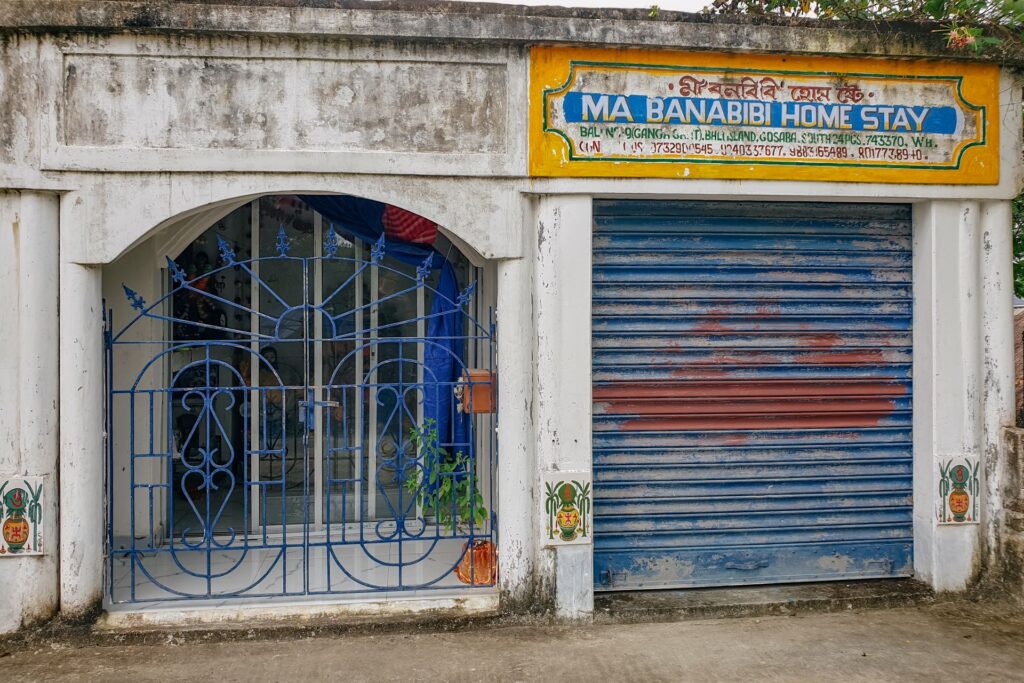
The forest is divided in that there is little to no transboundary cooperation around conservation, preservation, or restoration efforts. And yet it is united in the tremendous variety of trees that spread across the lands adjacent to the shared bay: there are said to be 26 species of mangroves with over 80 associated varieties.
Sundari is one of the most common species and since ‘bon’ means ‘forest’ in Bengali, the compound word Sundarbans means the ‘forest of Sundari,’ also home to the mighty Bengal tiger and mysterious evasive forest deity called Bonbibi.
The Story of Bonbibi
There are many variations of this tale that each time reinforce that a female deity resides in the Sundarbans. The story goes that there was once a young man who was down and out, without a job or livelihood. He was foraging in the forest for sustenance when a tiger came upon him. Sensing the imminent danger the young man was in, Bonbibi appeared and beat the tiger away with a stick (ghodaz). The story ends there as a symbol of her protective powers. The story of her struggle with another deity, Dakkhin Rai, is longer and for another time. There are little shrines (and some homestays) for Bonbibi in many places throughout the India Sundarbans: each with some incense, marigolds maybe, most often with a woman figure holding a stick standing or sitting next to her brother Shah Jangali. She is called upon mostly by the moule (honey collectors) and woodcutters before entering the forest for protection against tigers.
This divided forest is somehow united by the continual transport of low barges carrying fly ash from the factories of Kolkata to Dhaka, the capital of Bangladesh. Fly ash is the waste left from coal burning in incinerators that can be packed and processed to make bricks, cement, and other construction materials.
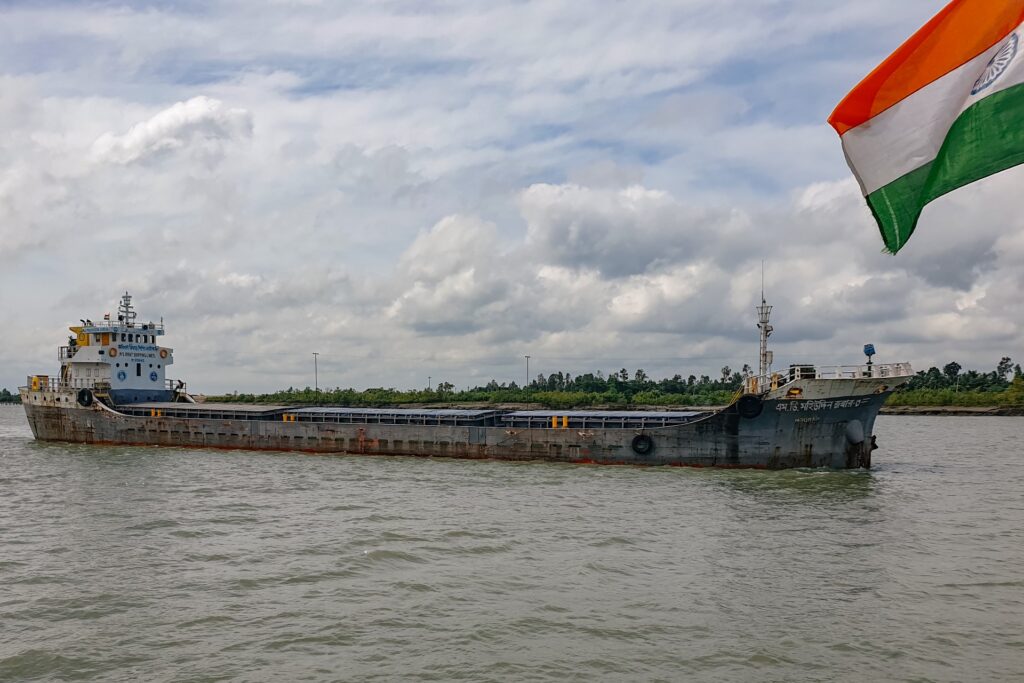
The barges ride the current downstream along the Hooghly River from Kolkata, turn off their engines, wait for the tide to rise (saving some precious cheap diesel fuel), and ride the rising tide up through the Sundarbans towards Dhaka. In a strange, convoluted way, this fly ash trade contributes somewhat to the circular economy.
The Highest Tide
The tides rise and fall with the waning and waxing of the moon. The highest tide (vora kotal) is with the full moon (poornima) and known as the ‘death tide’ (mora kotal). These salt tolerant mangrove forests have unique adaptations that allow them to survive in high salinity levels and tidal flooding. The great contemporary novelist and climate commentator, Amitav Ghosh, writes beautifully about the power of these currents and the speed at which they move in The Hungry Tide (2004), in which he describes the efforts to study and save the Irrawaddy dolphins that are largely going extinct.
The tide comes in twice a day, rising to a couple of meters during high tides, moving in and out between the roots of the mangroves, moving up and down the muddy banks. Tigers usually catch their favorite prey, the spotted deer, by the waterfront because it is harder to get them in the dense foliage inland. This imperceptive tide moves fast and represents the raw essence of life: uncontrollable yet predictable in its relentless force and persistence.
During high tide, visibility vanishes as it is next to impossible to see through the leaves. With the lower tides, it is possible to see further into the forest, beneath the canopy. Everything is affected by tidal conditions.
Fly ash is the waste left from coal burning in incinerators that can be packed and processed to make bricks, cement, and other construction materials.
The little red ‘fiddler’ crabs with their disproportionately big right pinchers enjoy digging in the mud, and the mudskippers (menumash in Bengali) thrive in the intertidal sludge on the banks where deer and tiger paw prints can be found. The tigers avoid the ‘breathing roots’ – those spikes protruding from the mud for the mangroves to aerate and not get too water-logged.
The tide is faster coming in, and slowest going up the rivers. The innumerous creeks visible a few hours ago between the different species of mangroves have now disappeared. There are so many creeks and little alleyways that cannot show up on Google Maps for the speed at which they are submerged by the rising tide, then reappear with the lower tides.
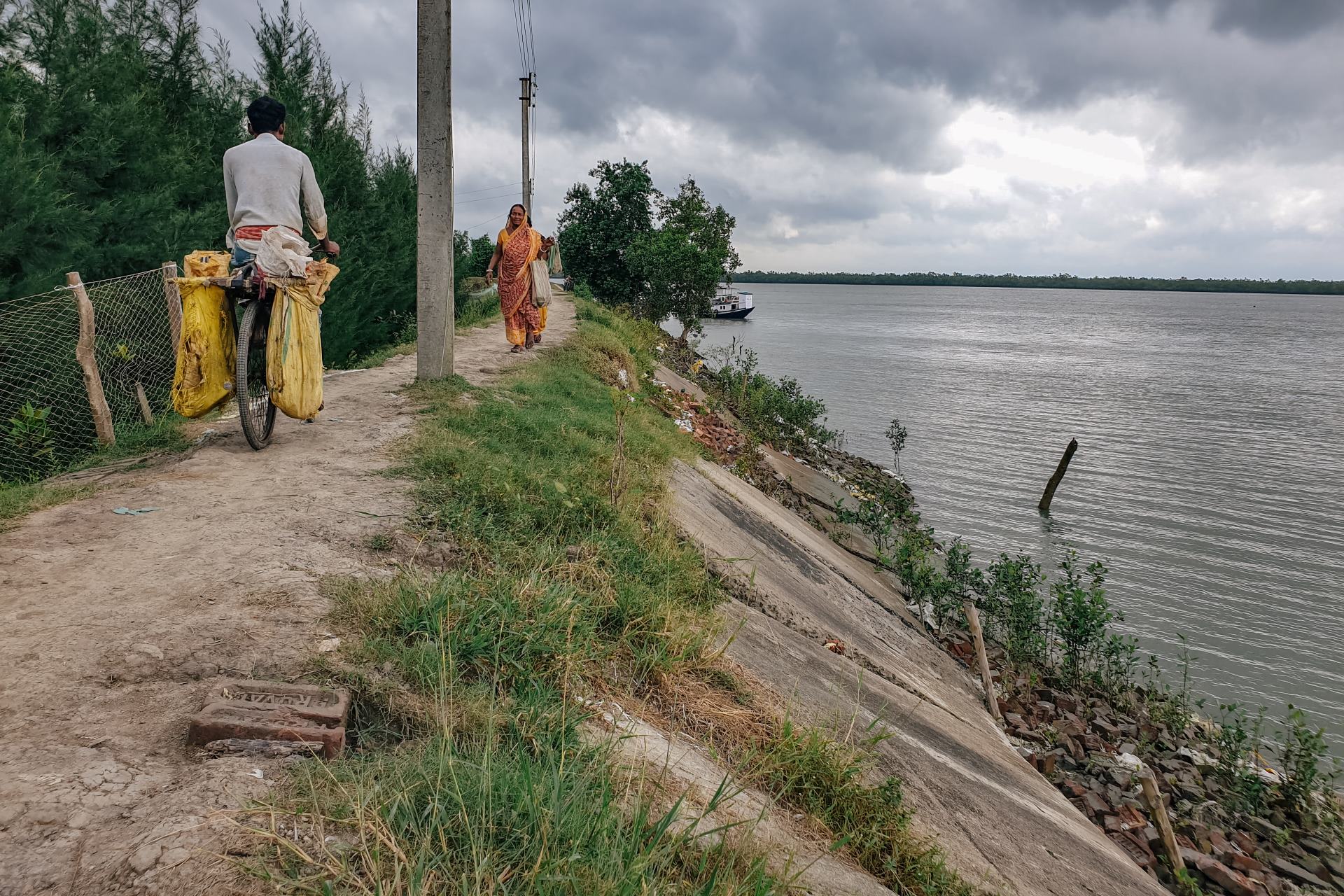
The Sundarbans are a primordial biome as they act as a dense buffer absorbing the impact of recurrent cyclones coming up off the Bay of Bengal, thwarting to some extent the devastation of the high winds and waves.
However, the mangroves could not stop the collapse of the cement path along the coast of Bally Island where the sea had eaten away, slowly but steadily, at the ground beneath the road. The collapsed cement looks like an embankment but is a sign of our utter lack of control of a serious situation struggling with the elements.
On Afforestation and Restoration
“The cyclones have intensified since I was a boy,” says Anil Mitri, founder (1999) and director of the Bali Nature (and) Conservation Society. “We are not going to repair this road. We are putting bricks in the water to help stop the waves for next time.” There are big investment plans to build breakwaters to stop the stormwater from crashing over the coast, but they are nowhere to be seen.
So, in the meantime, the best recourse is to plant trees and as many mangroves as possible to thwart the ‘severe,’ ‘very severe,’ or ‘extremely severe super cyclonic storms’ (as they are referred to by the Indian Meteorological Department – IMD) that come spinning up the Bay of Bengal.
With the support and partnership of the Sustainable Green Initiative (SGI) of India, Anil’s crew is busy planting different kinds of mangroves along the shallower inter-tidal zones, where men and women stand up to their knees in the thick gray mud.
The best recourse is to plant trees and as many mangroves as possible to thwart the ‘severe,’ ‘very severe,’ or ‘extremely severe super cyclonic storms’ that come spinning up the Bay of Bengal.
As the boat chugs through the Sundarbans, numerous plantation areas are visible by the lower height and lighter hue of the saplings, as well as by thin wooden spikes set in the mud connected by some fencing or string for the fishermen not to bring their boats there. White egrets and black cormorants like to rest on the thicker spikes. A white and black kingfisher drops over another wooden pole and flies across the water.
In 2022, Anil Mitri claims that his Bali Society planted over 600,000 bain, keora, and kankra mangroves, which could be due to the economies of scale in India and the fact that photos provided show hundreds of locals participating in the afforestation efforts. With satellite imagery from Google Earth, some of the sites shared by Anil include Nagendrapur, Rupamari, Sandeshkhali, Uttar Mokamberia, Nikarighata, Dighirpar, and Ramkarchar.
As of July–August 2023, they had planted some 70 lakhs (700,000) worth of trees in adjacent areas such as Amjhara, Kanthalberia, Madhusudhanpur-Ramkrishna, Madhusudhanpur, Chandipur, and Naraharipur.
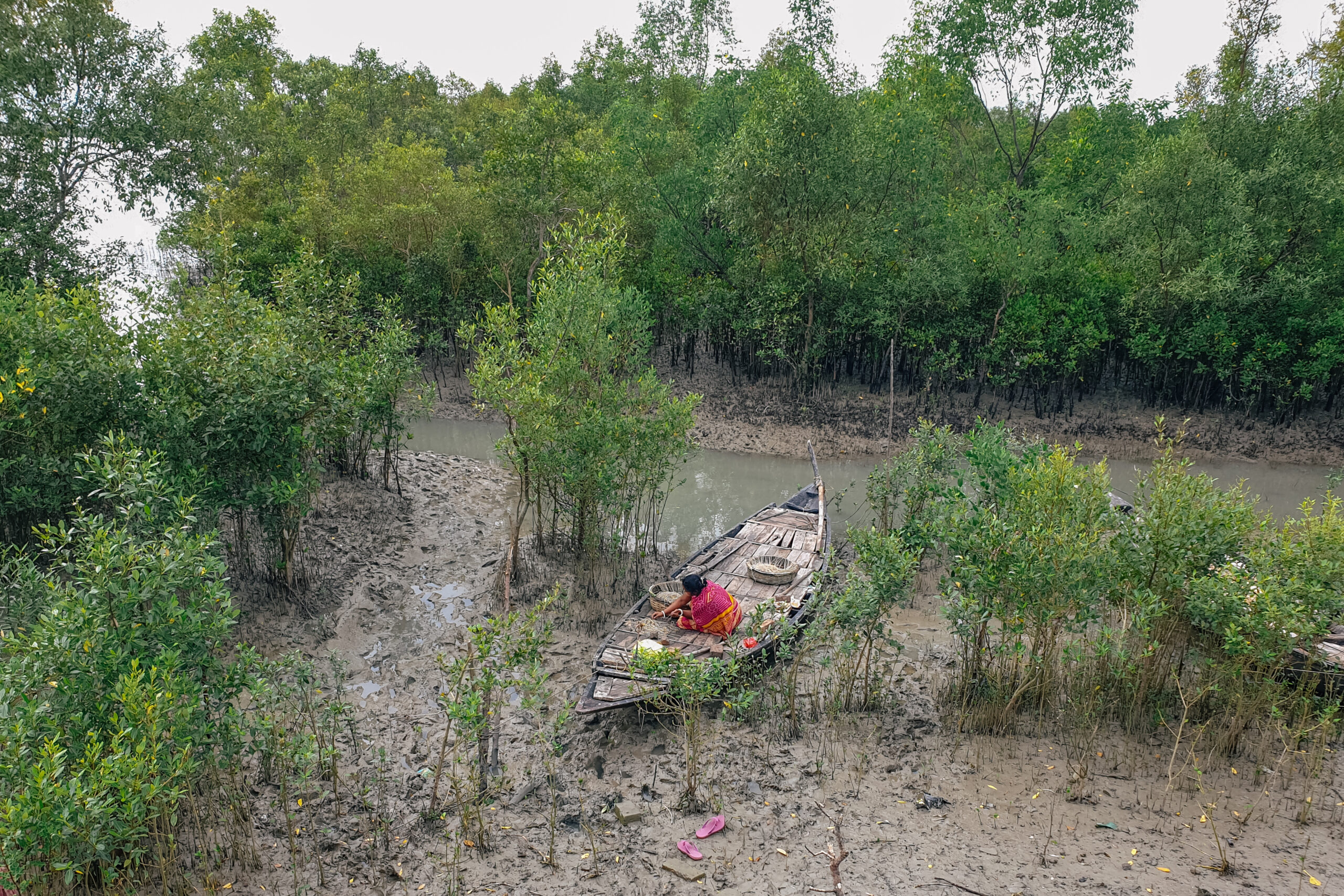
Where do all these mangroves come from? SGI has a large nursery in the town of Canning, inland from the Gadhlaki jetty by about a half hour, on the banks of the Matla River – also known as the ‘mad, drunk one’ for its volatility and unexpected movement. Access to this nursery from the main road is by moped and then on foot through derelict houses, some chicken coops, and over a rickety bamboo bridge that holds strong for all those crossing for a visit.
Hundreds, thousands of rows of baby mangroves grow in little black holders plugged into the moist earth. Canning is named after Lord Canning who was the first viceroy of India– he had great ambitions of establishing Kolkata as the capital and center of trade for the East India Company and the subsequent expansion and consolidation of the British Empire.
Back on the water, Anil brings his binoculars up to his glasses and scans the mangrove foliage. This low palm-like frond mangrove is called ‘hetal’ in Bengali, also known as ‘tiger bush’ locally. A tiger and her two cubs were spotted earlier in the morning here so the boat drives around in circles going back and forth along the banks, gazing into the bush.
“The tiger sees us,” Anil says, “but we can’t see the tiger.” This elusive magnificent beast blends in easily with the camouflage of the forest. “The tiger is king of the forest,” says Nabu, the local tour guide accompanying the sortie. No tiger spotted today.
Then the species of mangrove changes and these are the ‘walking trees’ with their long-legged roots that were made famous in Avatar: The Way of Water (2022), in which giant versions of these mangroves act as tree-houses for the Awa’Atlu, a Metkayina sea-village people, and as breakwaters in some sense, protecting them against the waves (natural elements) and invaders (humans).
Further on there is long dhami ghas (honey grass) that deer like to eat. “This is a good hunting spot for the tigers,” Anil explains and brings his binoculars to his glasses again.
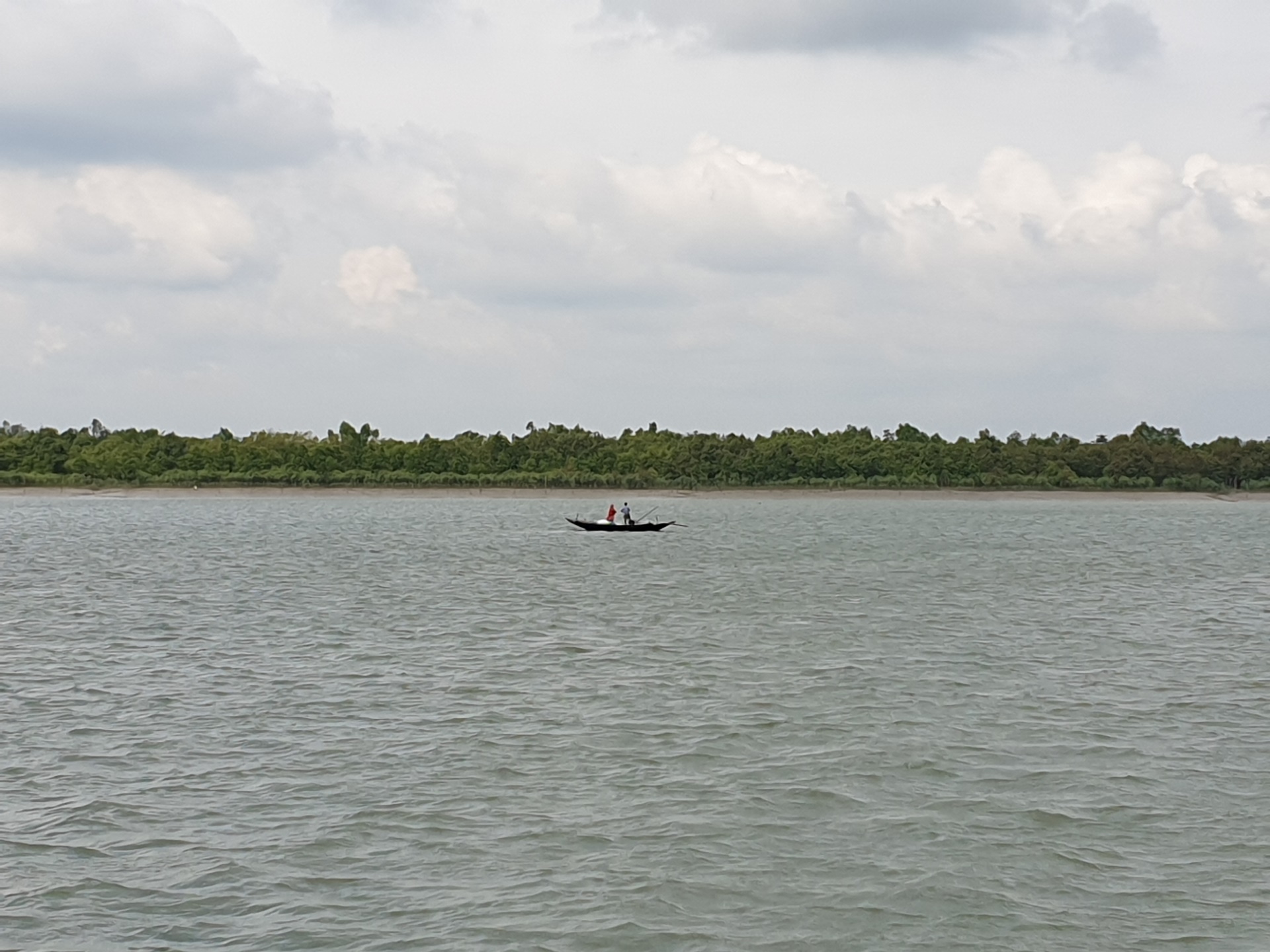
Anil was born and bred on the island of Bali adjacent to the Sundarbans. His family and neighbors were all ‘poachers’ but not in the Western sense of killing wild animals to sell their tusks or hides. Rather, they would hunt deer and fish. The Sundarbans and its environs are a fishing society.
Everyone has a story about a tiger here. Tigers visit the villages like dogs walk around neighborhoods in cities, mostly looking for food. “If you try to run, the tiger will kill you,” Anil says. His neighbors would call him when a tiger was visiting their village. He used his stunner gun to tranquilize one tiger, and another was too fierce and jumped at them. Like Bonbibi he used a stick to hit the tiger. “Tigers are in my heart,” he says, “they are part of my life.”
The boat passes the embankments of Bali Island where the roads have collapsed due to erosion from storms and seawater. The ‘Super Cyclonic Storm Amphan’ of May 2020 left unprecedented damage worth an estimated $13 billion. A broken cement jetty extends into the muddy waters. “We can plant more mangroves, but the water is still coming,” Anil says and shrugs off the apparent futility of the endeavor. Mangrove roots need soil to grasp onto; erosion also causes the death of the mangroves.
They have the most incredible capacity to survive in salty water with their unique breathing root system, but they need soil. Even the thick mud that fishermen sludge through up to their knees, casting out their nets by hand, is hard for the resilient mangroves to endure.
Ecosystem restoration and afforestation have their merits, but the volatile realities of incremental violent climate altercations are undeniable.
Ecosystem restoration and afforestation have their merits, but the volatile realities of incremental violent climate altercations are undeniable. On Etihad Airline flights, there are self-promotions playing on the TV screens embedded in the back-of-seats saying: “Adopt a mangrove tree in the Etihad forest” – as if emitting carbon emissions from flying could be compensated by adopting a tree.
In the United Arab Emirates, mangrove forests are becoming a luxury tourist destination. Here: emerging from the monotonous landscape of the Sundarbans, a woman in a bright orange sari is walking down another jetty that extends across the mud to the water; she gives a small parcel of food to two men who are sitting in a long wooden fishing boat, waiting languidly at the end of the pier; the orange fabric flaps in the wind, flickering like a flame against the grays and browns of the water and land; then she turns and goes back up the cement steps and walks along the path above the collapsed embankment, holding the orange cloth tossed over her black hair.
Curious to read more about similar topics? Have a look at our articles here.


